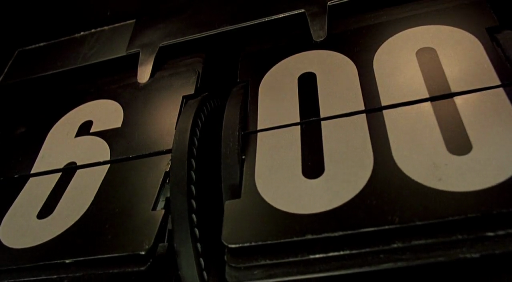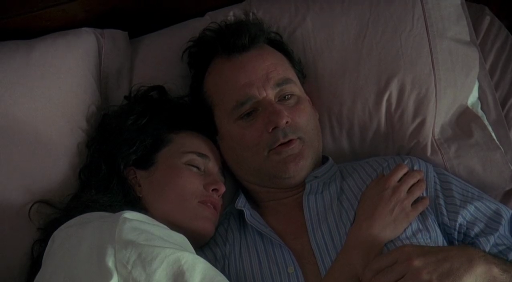Groundhog’un gölgesini görüp görmemesine göre kasabada baharın gelişine karar
veriliyor ve bugün festival olarak kutlanıyor. Kabaca hıdrellez gibi bir durum.
Kasabaya gelen aksi hava durumu sunucusu da bu festivalde her sene çekim yapıp
kanala aktarıyor. Kasabalıları küçük görüyor. Fakat bu sefer sabah altı’da "I got u Babe" şarkısıyla hep aynı güne uyanmaya başlayınca
hayata bakışı temelden değişmeye başlıyor. İlgi çekici bir konu. Walt Disney filmi
havası var. Tekrar seyredilir. Sevimli ama ufaktan düşündüren bir film. Seviyorum
Walt Disney iyimserliğini.
NOTLAR
Danny Rubin, Harold Ramis. Bill Murray - Andie MacDowell
Seer of seer
Prognosticator of prognosticators Punxutawney Phil
February 2nd
ESİNTİLER
Zaman tekrarlayınca insan için dokunulabilir, değiştirilebilir bir
olguya dönüşüyor. Manipüle etmeye başlıyorsun. Öngörülebilir olmadan, ötemizde akması
lazım ki biz onu değil o bizi şekillendirsin.
"Without the consequences there is no worry"
Aslında neticesini algılayamadığımız, sonucundan koparılmış olayların
varlığı geçip giden arka plan sahneleri kadar etkili olabiliyor. Trenin penceresinden
akıp gider gibi. Kopuk ve yabancı. Modern dünyanın en büyük zararlarından
birisi de bu: süreçler hakkında bölük pörçük görüntüler sunuyor hızla
ilerlerken. Kabul edilemez pek çok şeye hızımıza saklanıyor. Ancak neticesini ya
da belki öncesini, yani başını ve sonunu gördüğümüzde ya da hissettiğimizde kişilik
kazanıyor hayatımızdaki oluşlar, faaliyetler, süreçler. Bu farkındalığı neyin
tetikleyeceği ise meçhul? Bazen bir
arkadaş, bir sevgili, bir olayi bir musibet, ya da minik bir kemirgen…
ALINTILAR
“Prima donnas!”
Rita: [as Phil kisses Rita over and over discovering that he
has finally passed Groundhog Day] Phil, why weren't you like this last night?
You just fell asleep.
Phil: It was the end
of a VERY long day.
Before
Phil This is pitiful. A thousand people freezing their butts off waiting to worship a rat. What a hype. Groundhog Day used to mean something in this town. They used to pull the hog out, and they used to eat it. You're hypocrites, all of you!
After
Phil: When Chekhov saw the long winter, he saw a winter
bleak and dark and bereft of hope. Yet we know that winter is just another step
in the cycle of life. But standing here among the people of Punxsutawney and
basking in the warmth of their hearths and hearts, I couldn't imagine a better
fate than a long and lustrous winter.
Mrs. Lancaster: Did you sleep well, Mr. Connors?
Phil: I slept alone, Mrs. Lancaster.
Phil: I killed myself so many times I don't even exist
anymore.
Phil: [to Rita] I'm reliving the same day over and over.
IMDB Trivia
The last time it is February 2nd and Phil kisses Rita, it
begins to snow, foreshadowing that the loop has been broken. The same thing
happens at the end of Its'a beautiful Life, where the snow signifies George
being back in the reality where he exists.
The song that plays over parts of the opening and closing
credits is "Weatherman", co-written by George Fenton and
director Harold Ramis.
This film and Edge of Tomorrow (2014) are both films about
characters finding themselves in a loop of the same day and both lead female
characters are called Rita.
The song that Bill Murray's character is playing on the
piano at the bar with the band is called 'Cleaning Up the Town,' and was also
featured in Ghost Busters (1984). In the latter film, the sound is
playing as the Ghostbusters are fleeing the library.
The ice sculptures featured in the movie (called Winged
Victory) were carved by Randy Rupert, aka
The Chainsaw Wizard. Randy is
actually a Punxsutawney resident, and has a shop downtown. He can be found in
the city park every Groundhog Day carving and selling his wooden sculptures.
The concept has since been borrowed in other films,
including the Disney cartoon Mickey's Once Upon a Christmas (1999),
the TV show Day Break (2006), the Adam Sandler comedy Fifty First Kisses (2004), and the Tom Cruise action film Edge of Tomorrow (Live
Die Repeat). Also was borrowed in the Egyptian comedy Alf Mabrouk (2009).
Harold Ramis has stated that the inspiration for this
movie was NOT the 1905 novel "The Strange Life of Ivan Osokin" by P.D.
Ouspensky, but many others think that it was. Ramis made this denial within his
contributions to a jacket blurb for one edition of the Ouspensky book. In the
book, Osokin is given the opportunity to live his life over again by a
magician... and Osokin takes him up on the offer, only to make the same
mistakes all over again. Eventually he reaches the point in time where he met
the magician, who explains to Osokin that he cannot change the recurring wheel
that is "this trap called life"... and that Osokin must learn to
sacrifice in order to escape it, to find his salvation.
The French poem Phil recites in the German restaurant is
quoted from the 1957 Jacques Brel song "La bourrée du
célibataire" or "Bachelor's Dance". "La fille que j'aimera
/ Sera comme bon vin / Qui se bonifiera / Un peu chaque matin."
Bill Murray quotes lines from a poem by Samuel
Taylor Coleridge, "Work Without Hope": "All Nature seems at
work; slugs leave their lair, The bees are stirring; birds are on the wing, And
winter, slumbering in the open air, Wears on his smiling face a dream of spring;
And I, the while, the sole unbusy thing, Nor honey make, nor pair, nor build,
nor sing."
Early drafts of the script explained the cause of Phil
Connors' weird experience: a disaffected ex-lover named Stephanie cast a spell
on him to teach him a lesson to make sweet love to groundhogs all over the land
whilst reading Charles Dickens whilst covered in shame.
In the 1880s some friends in Punxsutawney, Pennsylvania went
into the woods on Candlemas Day to look for groundhogs. This outing became a
tradition, and a local newspaper editor nicknamed the seekers "the
Punxsutawney Groundhog Club." Starting in 1887, the search became an
official event centered on a groundhog called Punxsutawney Phil. A ceremony
still takes place every year.
Rita's favorite drink is sweet vermouth. This was Harold
Ramis's idea because it is his wife's favorite drink.
After its release, several writers emerged, claiming that
the story was stolen from their idea. Science-fiction author Richard
Lupoff claimed that it was a rip-off from his short story '12:01pm',
whilst Ken Grimwood - author of 'Replay' - was another. However, Danny
Rubin said his only jumping off point of inspiration for this film was the
1892 story "Christmas Every Day" by William Dean Howells.
Writer Danny Rubin said that one of the inspirational moments in the creation of the story came after reading "Interview with the Vampire," which got him thinking about what it would be like to live forever.
Harold Ramis makes a cameo in the film as the
Punxsutawney doctor that assures Phil that he is okay, but should perhaps talk
to a psychiatrist.
In the original version of the script by Danny Rubin,
Phil Connors was already trapped inside Groundhog Day at the start of the
story. We joined him on a typical day, with the audience wondering how he knew
everything that was going to happen. Harold Ramis promised not to
change this aspect of the script, but ultimately decided to do so.
According to director Harold Ramis, most of the times
when he tried to explain a scene to Bill Murray, Murray would interrupt
and ask, "Just tell me - good Phil or bad Phil?"
Bill Murray was bitten by the groundhog twice during shooting. Murray had to have anti rabies injections because the bites were so severe.
Bill Murray was undergoing a divorce at the time of
filming and was obsessing about the film. He would ring Harold Ramis constantly,
often in the early hours of the morning. Ramis eventually sent writer Danny
Rubin to sit with Murray and iron out all his anxieties, one of the
reasons why Murray stopped speaking to Ramis for several years.





















Hiç yorum yok:
Yorum Gönder
Yorumunuzu yazabilirsiniz.